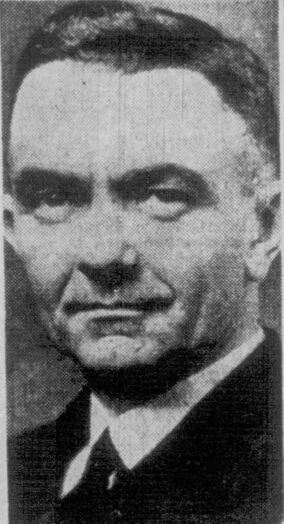JOHN G. BURROW, CDR, USN
John Burrow '21
Lucky Bag
From the 1921 Lucky Bag:
John Giles Burrow
Pensacola, Florida
"Woof-Woof" "Johnnie-B"
FLORIDA and the Sunny South never knew what it missed when it let J. G. enter the Navy, but it took just one Sep leave for him to discover what he missed when he left Florida. Followed by a great volume of mail, his feeble excuse for the change which came over him was that he had been working hard to get his aviators wings but we surmised that the wings in the case belonged to the possessor of a bow and arrow and a face almost as cherubic as John's.
When a mere child, his one absorbing ambition was to become a minister which fact causes us to devoutly repeat the old verse, "Make him a child again, just for tonight." He still longs to be a "Sky Pilot" but has made a change in tactics, as it were, his field of strategy now being Naval Aviation. That Sep leave he shocked all the "Jazz" ensigns of Pensacola by appearing in a "Limy" blouse with three diags. First Class year he turned hard as nails which made us look askance at the minister story. But now that it's all over, here's to you, old scout. One look at that beatific smile of yours June Week has made us doubt the fun of being a Red Mike.
Buzzard; Mandolin Club (3, 1); Sub Squad (1).
The Class of 1921 was the last of the wartime-accelerated classes. "1921A" was graduated on June 3, 1920; the second half, "1921B", was graduated on June 2, 1921. John was graduated with 1921A.

John Giles Burrow
Pensacola, Florida
"Woof-Woof" "Johnnie-B"
FLORIDA and the Sunny South never knew what it missed when it let J. G. enter the Navy, but it took just one Sep leave for him to discover what he missed when he left Florida. Followed by a great volume of mail, his feeble excuse for the change which came over him was that he had been working hard to get his aviators wings but we surmised that the wings in the case belonged to the possessor of a bow and arrow and a face almost as cherubic as John's.
When a mere child, his one absorbing ambition was to become a minister which fact causes us to devoutly repeat the old verse, "Make him a child again, just for tonight." He still longs to be a "Sky Pilot" but has made a change in tactics, as it were, his field of strategy now being Naval Aviation. That Sep leave he shocked all the "Jazz" ensigns of Pensacola by appearing in a "Limy" blouse with three diags. First Class year he turned hard as nails which made us look askance at the minister story. But now that it's all over, here's to you, old scout. One look at that beatific smile of yours June Week has made us doubt the fun of being a Red Mike.
Buzzard; Mandolin Club (3, 1); Sub Squad (1).
The Class of 1921 was the last of the wartime-accelerated classes. "1921A" was graduated on June 3, 1920; the second half, "1921B", was graduated on June 2, 1921. John was graduated with 1921A.
Loss
John was lost on May 1, 1942 when the United Air Lines aircraft he was aboard crashed into Ensign Peak, Utah, near Salt Lake City.
Other Information
From the Cincinnati Enquirer on May 3, 1942:
Commander John Giles Burrow and Lieutenant Claire Sheldon Tucker of the navy would not have been aboard the ill-fated ship were it not for their thoroughness in their work. They had taken reservation on a plane leaving Reno, Nev., Thursday but canceled them to devote another day to investigating the possibility of establishing naval training station at Pyramid Lake.
He is buried in Arlington National Cemetery.
Another alumni, Frederic Vose '22, was also lost in this crash, but it does not appear he was on active duty at the time.
Biography
From researcher Kathy Franz:
John’s father was a pioneering newspaper publisher in Pensacola, Florida. His mother was Nelle, and his sister was Dorothy, a school teacher. His brother was Lieutenant James B. Burrow (Class of 1933) who at the time of John’s death was an instructor at the Naval Academy. John married Johnnie Mae Dunn Levey on May 9, 1921. They had two daughters Betty and Laurel Jean. Three weeks after his death, Betty married Ensign H. Cushman Dow, USNR.
In 1915, John was president for the Junior Mission Band of the First Presbyterian Church. In 1917, he was its secretary. John played the violin.
In 1936 John was named the commander of the U.S.S. Philip, recently determined the No. 1 destroyer of the Navy. The San Diego Union newspaper quoted John: “We haven’t been out particularly for a gunnery record. What we have been doing is perfecting team-work – getting the engineers and the deck and the communications people all working together. The record in gunnery just followed naturally. The credit for that end of it is due entirely to the work of the gunnery officer and his men.” Ens. D. L. L. Cordiner (Class of 1934), is gunnery officer of the Philip and became the victim of a “quaint old naval custom” when he won the prize – a dunking overboard. All members of the craft were awarded extra prize money for the record.
In 1937 the U.S.S. Philip was decommissioned. The Pensacola News Journal printed John’s farewell address: “Our guests and shipmates of the Philip: We have assembled here this afternoon to decommission one of the first and one of the last of the destroyers of the 1916 building program. I am happy to see that our former squadron commander, the captain of the Rigel, and so many old Philip shipmates, could be with us for this ceremony.
“The keel of the Philip was laid at Bath, Maine, September 1, 1917. It was launched July 25, 1918, and placed in commission August 24, 1918. It was named in honor of Rear Adm. John Woodward Philip, a native of New York State who died in 1900 at the age of 60 and after a most distinguished career in the Navy. He performed gallant services in the Civil War, was courageous in action in China and was advanced in rank for gallantry while in command of the battleship Texas during the engagement of the American and Spanish forces at Santiago, Cuba, in 1898.
“Burrow also told of the happy days he had experienced during the last nine months, while in command of the Philip, and said although the vessel was declared over age in August, 1930, it had outlasted its allocated time and ‘still had a good fight in it.’ He also told of the excellent gunnery record made during the present fiscal year by the Philip, its other records and achievements. He was given three cheers by his small contingent, those remaining on board to place the vessel out of commission.
“Only three officers remained. Aside from the commanding officer they were Lt. (jg) F. E. Wilson and Ens. D. L. Cordiner. Lt. H. E. Day was detached March 31 and now is on duty at the bureau of operations in Washington, Lt. E. B. Taylor was detached last January and is now executive officer of the Perry and Ens. John Stuart was detached January 1, and is now attached to the Dallas.
“The last member of the crew, aside from the captain, to leave the ship was ‘Lettle Jughaid, the bull terrier mascot of the Philip. He is being transferred, record and all, to the destroyer Borie.”
Photographs
Career
He was commanding officer of USS Philip (DD 76) from July 10, 1936 to March 5, 1937. In 1940 he was serving aboard the USS West Virginia as the Damage Control Officer.
The "Register of Commissioned and Warrant Officers of the United States Navy and Marine Corps" was published annually from 1815 through at least the 1970s; it provided rank, command or station, and occasionally billet until the beginning of World War II when command/station was no longer included. Scanned copies were reviewed and data entered from the mid-1840s through 1922, when more-frequent Navy Directories were available.
The Navy Directory was a publication that provided information on the command, billet, and rank of every active and retired naval officer. Single editions have been found online from January 1915 and March 1918, and then from three to six editions per year from 1923 through 1940; the final edition is from April 1941.
The entries in both series of documents are sometimes cryptic and confusing. They are often inconsistent, even within an edition, with the name of commands; this is especially true for aviation squadrons in the 1920s and early 1930s.
Alumni listed at the same command may or may not have had significant interactions; they could have shared a stateroom or workspace, stood many hours of watch together… or, especially at the larger commands, they might not have known each other at all. The information provides the opportunity to draw connections that are otherwise invisible, though, and gives a fuller view of the professional experiences of these alumni in Memorial Hall.
January 1921
January 1922
May 1923
July 1923
September 1923
November 1923
January 1924
March 1924
May 1924
July 1924
September 1924
November 1924
January 1925
March 1925
May 1925
July 1925
October 1925
January 1926
October 1926
January 1927
April 1927
October 1927
January 1928
April 1928
July 1928
LCDR Norman Scott '11
LCDR Albert Rooks '14
LCDR Cassin Young '16
LT John Gillon '20
LT Joseph Hubbard '21
LT Edwin Crouch '21
LTjg Howard Healy '22
LTjg William Ault '22
October 1928
January 1929
April 1929
July 1929
October 1929
January 1930
April 1930
October 1930
January 1931
April 1931
July 1931
October 1931
January 1932
April 1932
October 1932
January 1933
April 1933
July 1933
October 1933
April 1934
July 1934
October 1934
January 1935
April 1935
October 1935
January 1936
April 1936
July 1936
January 1937
April 1937
September 1937
January 1938
July 1938
January 1939
October 1939
June 1940
November 1940
April 1941

The "category" links below lead to lists of related Honorees; use them to explore further the service and sacrifice of alumni in Memorial Hall.
